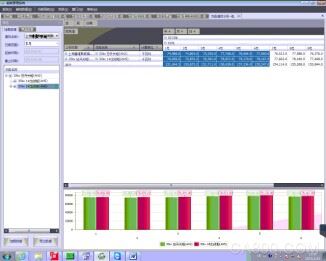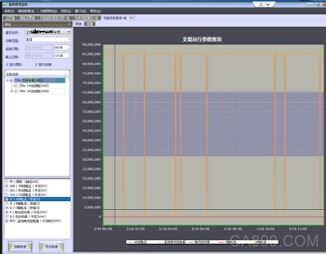Application of Acrel-5000 Energy Management System in Shanghai New Hongqiao Club Project
Wu Haiying 1
1 Ankerui Electric Co., Ltd., Jiading 201801, Shanghai, China;
Abstract: The total area of ​​large-scale public buildings is less than 4% of the total area of ​​urban buildings, but the total energy consumption accounts for 22% of the total electricity consumption in cities and towns in China. The annual consumption of large-scale public buildings per unit area reaches 70 to 300KWh, which is an average residential building. 10 to 20 times. Public buildings are important for energy conservation and energy conservation. To do a good job in energy conservation in public buildings is of great significance to promoting and stimulating energy conservation in the entire society, achieving energy conservation and emission reduction targets, and implementing the major strategy of “turning modes and adjusting structuresâ€. This article describes the Shanghai New Hongqiao Club project, using smart power meters to collect various electrical parameters at the distribution site. The system adopts the on-site local networking method. After networking, it communicates via the field bus and transmits it to the background. The Acrel-5000 building energy consumption monitoring system realizes power monitoring and management of the distribution circuit.
Keywords: Shanghai New Hongqiao Club; large-scale public buildings; energy consumption monitoring system; ACREL-5000;
1 Introduction
At present, China is already the world’s second largest energy producer and consumer. According to statistics, China’s building energy consumption accounts for about 28% of the country’s total energy consumption. In China’s newly built 2 billion square meters of buildings, 99% of which are It is a high-energy-consuming building; only 4% of the existing buildings have adopted energy-saving measures. Large-scale public buildings not only have high energy density, but also have very serious energy waste. They have huge space for energy conservation. The promotion of building energy-saving is imperative, and energy saving and consumption reduction are the first measures.
The relevant local regulations require that “the building energy consumption monitoring system should be included in the construction plan as part of the new construction equipment and facilities system; the Shanghai New Hongqiao Club project belongs to large-scale public buildings, and the Shanghai energy consumption monitoring and design basis is mainly based on “DGJ68-2068-2012. 》Technical specifications for public buildings can be monitored.
2 Design basis
DGJ08-2068-2012 Shanghai Municipal Public Building Energy Monitoring System Engineering Technical Specification
"Evaluating the rational use of electricity technology guidelines GB"
"General Rules for the Preparation of Energy-saving Planning for Enterprises"
Corporate Energy Auditing Technology General-GB
GBT23331-2009 Energy Management System Requirements
GB-50052-2009 "Power Supply and Distribution System Design Specifications"
â—† Energy consumption measurement device national and industry standards
DL/T 645-1997 Multifunctional Energy Meter Communication Protocol
DL/T 645-2007 multi-function energy meter communication protocol
GB/T 19582-2008 Industrial Automation Network Specification Based on Modbus Protocol
3 Project Overview
The new Hongqiao Club project is located at No. 35, Loushanguan Road, south of the new Hongqiao Building. It is adjacent to Shanghai Shimao Shopping Mall in the west and Yan'an West Road in the south, facing the International Exhibition Center. After the reconstruction, it was an eight-story square-shaped commercial building with a total construction area of ​​10,000 square meters above ground and 10,130 square meters underground, with a building density of 19.4%.
4 System Architecture
Acrel-Acrel-5000 building energy management system is networked according to the actual situation of Shanghai New Hongqiao Club project site. The overall network structure is connected to the fire control center's collector via shielded twisted pair cable, and the data is uploaded to the server through the network. .
The system mainly adopts a hierarchical distributed computer network structure, as shown in the system structure diagram: station control management layer, network communication layer and field device layer. Among which, Shanghai New Hongqiao Club project site equipment is distributed as follows: 56 ACR multi-function meters, 13 smart flow meters, and 31 smart water meters;

System structure
5 System Software Module
â—† Comprehensive energy consumption main interface

Reflect the energy consumption of each category in the year of the building and convert it into the equivalent energy consumption of standard coal, and calculate the energy consumption per unit area;
Although there are many types of energy consumption in a building, the main energy, water, gas, and renewable energy sources that can be measured by meters are displayed. The energy consumption curve of the four types of energy consumption is displayed on the interface at the bottom of the day; click each The upper area of ​​the classification energy consumption can be jumped to the energy consumption analysis main interface of the classification energy consumption;
The building can be switched through the drop-down box. The building picture can be replaced according to the project requirements;
â—† Classified energy consumption main interface

Reflect the energy consumption (for example, electricity) of a certain category and the same period of yesterday, the same period of previous month, the energy consumption and comparison of the same period of the previous month, the same period of the previous month, the current year and the same period of the previous year, the growth percentage and the added value;
Reflect energy consumption trends of the past 48 hours, the past 31 days, the past 12 months, and the past 3 years of a certain classification energy consumption;
The monthly energy pie chart reflecting the energy consumption of a certain item;
Reflecting the energy consumption of a certain category in the same year, the monthly energy use analysis graph;
â—† Classification energy consumption branch energy statistics report

The branch can be flexibly selected, and the daily, monthly, weekly, seasonal and annual energy use of branch energy during a certain period of time can be calculated;
Through the powerful function of the pivot table, the user can perform a variety of data statistics and sort the data in combination;
Statistical data can be displayed by various charts such as histograms, dotted charts, stacked charts, and pie charts;
Statistics can be exported to Excel;
â—† Classified energy consumption branch non-working daily energy

Statistics on working days and non-working days for each branch, and non-working days can be set flexibly through the system
Statistics can be exported to Excel;
â—† Category energy consumption branch year-on-year analysis

Statistics on the monthly energy use for each branch and the energy consumption for the same period last year;
â—† Classified energy consumption branch energy use

Query the meter readings for any two branches of each branch and calculate the difference;
Time accuracy to minutes;
â—† Classification energy consumption branch time energy use trend analysis

The energy consumption parameters (for example, voltage, current, power, power factor, etc.) of any branch can be queried during a certain period of time. The specific queryable parameters are related to the installed instrument and system configuration.
The data is displayed in the form of a chart or table. The chart can be zoomed in, zoomed out, or moved by mouse operation; the data can be sorted (maximum, minimum);
Data can be exported to Excel;
â—† Configuration Options
According to the relevant technical specifications, the basic information of the building is configured, such as: building function, building area, air conditioning area, building address, etc., in which the building area and other information will be used to analyze energy consumption per unit area;
Configure the basic information such as the type, model, and manufacturer of the instrument used in the project, and add the monitoring parameter information that can be provided by this type of instrument. Here, the configuration affects the energy consumption statistics, statistics of energy consumption over time, and parameter query functions;
All metering instruments used in the configuration project, save metering instrument address, transformation ratio, corresponding collector, code, monitoring circuit name and other information;
The information related to metering, proportioning, and calculation methods involved in configuring itemized energy consumption statistics can be flexibly configured according to the situation of the project. The configuration information here will affect the energy consumption analysis of each classification. ;
Configure the measuring instruments, computing methods, proportions, and department energy plans for each department's energy use. After completing this configuration, the department's energy consumption analysis module will be enabled.
Configure the meter, calculation method, and proportion of an energy use area in the building. After completing this configuration, the regional energy consumption analysis module will be enabled.
6 Outlook
According to the analysis of energy consumption and operation effect of Shanghai New Hongqiao Club Project, a typical energy consumption analysis model was established and analyzed.
â—† Establish a building energy consumption measurement system, grasp the energy consumption of buildings, discover the shady energy consumption, and make more energy-saving changes. At the same time, we must consolidate the results of energy-saving transformation through management measures such as measurement fees and performance assessment.
â—† Select energy-saving equipment (inverter, heat recovery device).
â—† No matter how good the energy-saving equipment is, it can't control waste, and it can't exert energy-saving effects. By increasing automation energy-saving equipment, formulating equipment operation strategies, reducing human intervention, and centralizing management and control, energy-saving equipment is achieving energy conservation.
â—† Quantify the results of energy-saving transformation through the same loop analysis data provided by the energy consumption monitoring system to maximize the energy-saving effect.
7 Conclusion
The total area of ​​large-scale public buildings is less than 4% of the total area of ​​urban buildings, but the total energy consumption accounts for 22% of the total electricity consumption in the country's cities and towns. The annual consumption of large-scale public buildings per unit area reaches 70 to 300KWh, which is 10 for ordinary residential buildings. ~ 20 times. Public buildings are important for energy conservation and energy conservation. To do a good job in the energy conservation of the Shanghai New Hongqiao Club project is of great significance in promoting and stimulating energy conservation and achieving energy conservation and emission reduction targets.
references:
[1]. Technical requirements of the Ministry of Housing and Urban-Rural Development
[2].DGJ08-2068-2012 "Shanghai Public Building Energy Monitoring System Engineering Technical Specifications"
About the Author:
Wu Haiying, female, undergraduate, Ankerui Electric Co., Ltd., the main research direction for the smart grid power distribution, Email: mobile phone QQ
Right Angle DIP Centronic Connector
Right Angle DIP Centronic Connector.
Current Rating:5A
Dielectric Withstanding Voltage:1000V for one minute
Insulation Resistance:1000MΩ Min.(at 500V DC)
Contact Resistance:35mΩ Max.
Temperature:-55°C to +105°C
Right Angle DIP Centronic Connector
ShenZhen Antenk Electronics Co,Ltd , https://www.antenkconn.com